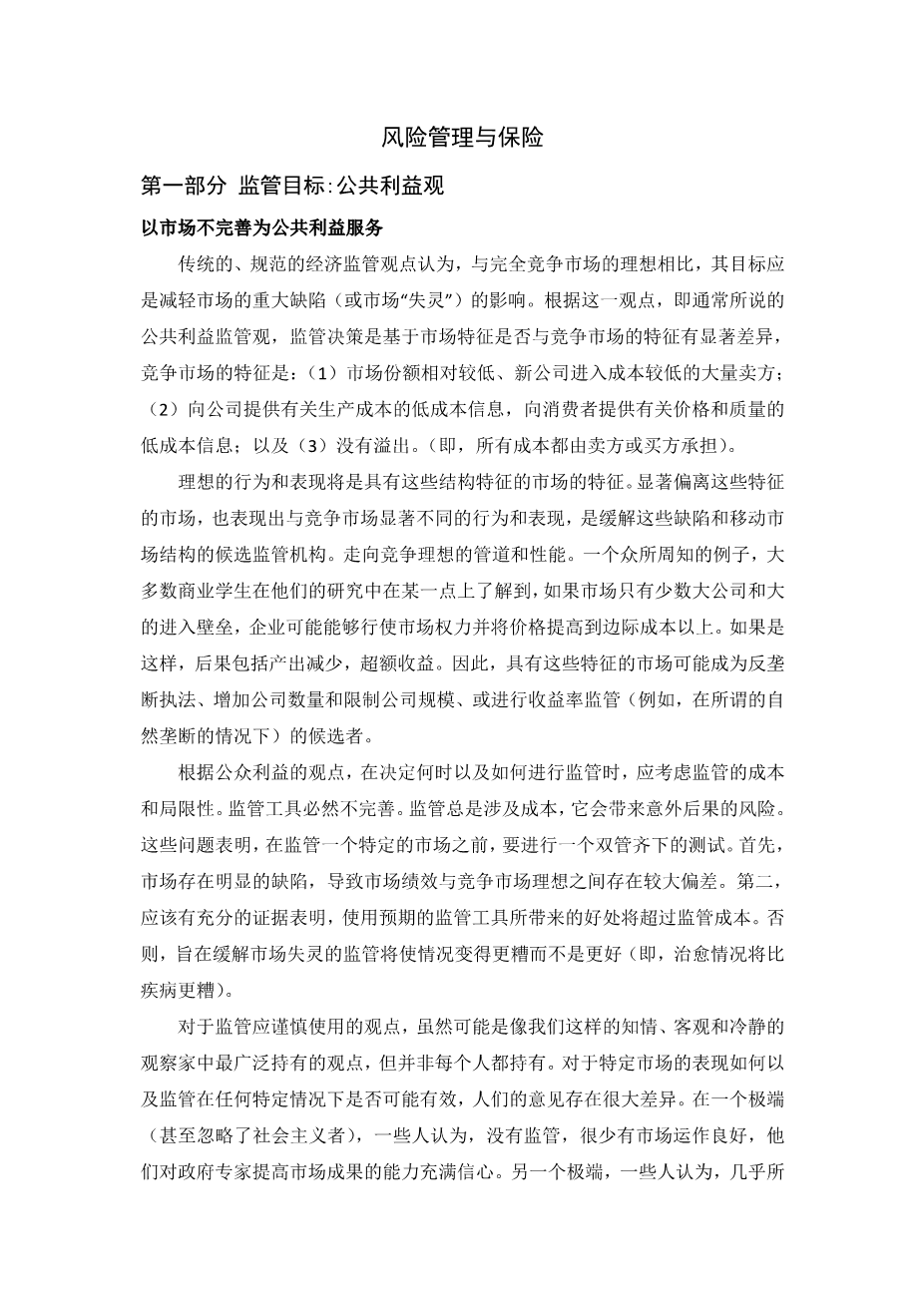RISK MANAGEMENT AND INSURANCE
Part 1 Objectives of Regulation:The Public Interest View
Serving the Public Interest by Mittigate Market Imperfection
The classical,normative view of economic regulation is that its objective should be to mitigate the impact of significant market imperfections(or market “fail-ures”)compared to the ideal of a perfectly competitive market.According to this view,which is commonly known as the public interest view of regulation,the decision to regulate is based on whether characteristics of the market differ significantly from those of a competitive market characterized by:(1)large numbers of sellers with relatively low market shares and low cost entry by new firms;(2)low cost information to firms concerning the cost of production and to consumers concerning prices and quality;and(3)an absence of spillovers(i.e.,all costs areinternalized to sellers or buyers).
Desirable conduct and performance will characterize markets with these structural characteristics.Markets that significantly deviate from these characteristics and also exhibit conduct and performance that differ significantly from a competitive market are candidates for regulation to mitigate these imperfectionsand move the market#39;s structure,conduct,and performance toward the competitive ideal.A well-known example,which most business students learn about at some point in their studies,is that firms may be able to exercise market power and raise prices above marginal costs if the market has only a few large firms and large entry barriers.If so,the consequences include reduced output,excess profits,and an overall reduction in welfare.As a result,markets with these characteristics may be candidates for antitrust enforcement,to increase the number and limit the size of firms,or for rate of return regulation(e.g,in the case of a socalled natural monopoly).
According to the public interest view,the costs and limitations of regulation should be considered when deciding when and how to regulate.Regulatory tools are necessarily imperfect.Regulation always involves costs,and itentails the risk of unintended consequences.These problems suggest a two-pronged test before regulating a given market.First,there should be demonstrable market imperfections that lead to a significant deviation between market performance and the competitive market ideal.Second,there should be substantial evidence that the benefits from using the regulatory tool being contemplated will exceed the costs of regulation.Otherwise,regulation that is intended to mitigate market failure will make matters worse rather than better(i.e.,the cure will be worse than the disease).
The view that regulation should be used cautiously,while perhaps the most widely held view among informed,objective,and dispassionate observers like us),is not held by everyone.Opinions vary substantially concerning how well particular markets perform and whether regulation is likely to be effective in anygiven case.At one extreme(even ignoring socialists),some people believe that very few markets work well without regulation,and they are confident in the ability of government experts to improve on market outcomes.At the other extreme,some people think that almost all markets work reasonably well in conjunction with contract enforcement by the courts,and they doubt that regulation will be effective for markets that do not.
An Example of the Public Interest View:Dealing with Costly and Imperfect Information Aithough it does not imply that insurance regulation by and large minimizes the cost of risk in practice (see below),many of the regulatory tools summarized in Table 24-i are related to imperfections in insurance markets.In particular,insurance markets often are characterized by imperfect and costly information.Consumers are not fully informed about product quality and becoming better informed is costiy.Much insurance regulation is related to these information problems,including,for example,licensing of insurers and agents,solvency regulation,regulation of contract language,regulation of deceptive sales and unfair claims practices,and information disclosure rules.
The court system can address some problems related to imperfect information,such as litigation that alleges misrepresentation by an insurer in its sales practices or improper refusals to settle claims.However,reliance on the courts to settle disputes expost often will not be an effective or efficient means of mitigating information-based problems,so that regulation may be desirable.If,for example,costly and imperfect information causes people to inadvertently buy coverage from a financially weak insurer that later fails,litigation following insolvency will be unable to compensate policyholders for their losses because the defendant will be insolvent.Moreover,the threat of such litigation obviously will not deter excessively risky behavior by insurers prior to failure.Costly and imperfect information also may lead to comparatively small harms to many people that might be more efficiently addressed by regulation than litigation.
Why Some Unregulated Markets May Not Provide Adequate Information.
Obtaining information about the quality of insurance is costly to consumers (it requires time and effort).Information that is available to consumers usually will be imperfect,which increases the risk that some consumers will inadvertently buy coverage from a company with lower quality than the consumer is willing to pay for.Incentives for insurers or other parties to provide useful information are reduced by the cost of producing the information and several additional factors,in.cluding:
·In an unregulated environment with imperfect information,it may be difficult or impossible for high quality insurers to develop accurate measures to demonstrate their quality that can be readily understood by most consumers.
·If high quality insurers advertise their q
全文共21118字,剩余内容已隐藏,支付完成后下载完整资料


英语译文共 7 页,剩余内容已隐藏,支付完成后下载完整资料
资料编号:[453463],资料为PDF文档或Word文档,PDF文档可免费转换为Word


